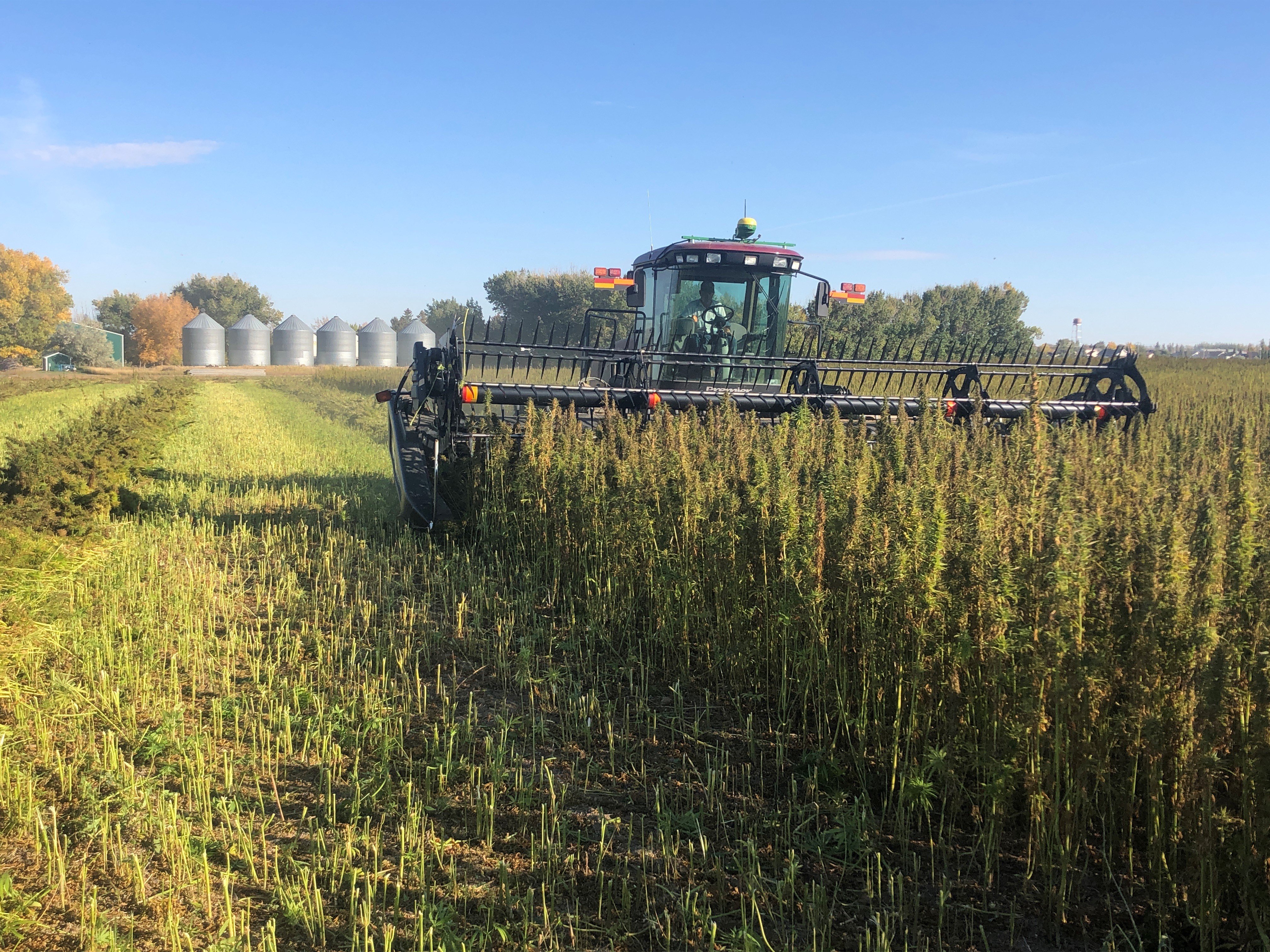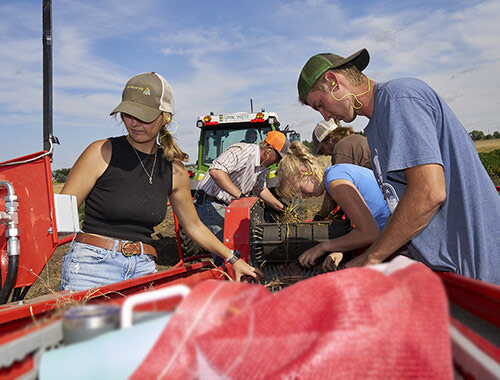From the Spring 2023 Farming Smarter Magazine
By Kristi Cox
|
|
|
Image Caption: Hemp swathing at Specialty Seeds Ltd. Photo: Will Van Roessel |
Weed control is important in hemp whether it is used for seed, food, or fiber production. Farming Smarter in Lethbridge, InnoTech in Vegreville, and SARDA Ag Research in Falher collaborated on a study to look at efficacy of different herbicides in different varieties of hemp. This one-year study spanned the three regions and looked at both broad leaf and grassy weed control.
Will Van Roessel, co-owner of Specialty Seeds near Bow Island, Alberta has been growing hemp since 2010 for both pedigreed seed and food production. He explained that if hemp is grown for fiber, weeds at harvest can decrease the fiber quality. If it’s grown for grain or seed, then all the weed seeds must be cleaned out before it can be used for planting or human consumption. Many weed seeds are similar in size, shape and colour to hemp seed, making it difficult to separate.
“We’ve got a couple of weed pests that tend to be an issue in hemp crops,” said Mike Gretzinger, research coordinator at Farming Smarter. “Volunteer canola can be an issue. If it survives into the grain sample it’s hard to separate. Buckwheat can be an issue, and we’re starting to have issues with group one and two resistant wild oats.”
Currently, only Edge and Assure II are registered for hemp. It’s important to have a broad selection of herbicides to choose from to reduce the risk of weeds becoming resistant to certain types of herbicides.
“(Hemp is) a relatively new (commercial) crop in Canada compared to other crops,” said Van Roessel. “Some other relatively new crops might have significant acres in the U.S., so we can draw on their experiences and their list of herbicides that worked well for them for weed control. But that’s not the case with hemp. In Canada, we're probably 20 years ahead of the U.S. in terms of hemp production.”
Gretzinger explained that the herbicides for the trial were chosen after going back through literature to see what had been tested before and what hadn’t been tried. They also wanted to look at new combinations or ways of using some of the products.
They chose two cultivars for testing, Silesia, a grain cultivar of hemp and Katani, a fiber or dual-purpose cultivar.
The trial was split in two sub-trials, one for broadleaf weeds and one for grassy weeds. All were tested in all three locations with planted weeds, and they used Canadian Weed Science Society scales for measuring crop tolerance and weed control at intervals up to 40 days after application. They also looked at grain yield for grain crops and fiber biomass for fiber crops. Gretzinger explained they wanted to ensure that herbicides appearing to be well tolerated didn’t adversely affect yield. All results were compared to an untreated control.
Weeds were planted perpendicular to the plot.
“It was a lot weedier than I think commercial field would be,” said Gretzinger. “I think farmers are a little more careful to make sure they've got a good three four-year rotation and clean fields before they grow hemp.”
Broadleaf Weeds
For broadleaf weeds, they evaluated twelve herbicide treatments using four herbicides at differing rates. Pardner and Authority II showed the least damage to both the Katani and Silesia cultivars while Odyssey and Pursuit showed the most.
Pardner appeared to be the best option for broadleaf weed control. It did not damage the cultivars and offered sustained efficacy.
Gretzinger explained that Authority II is used as a pre-seed treatment in front of many crops, including peas, flax, and chickpeas and known for good control against kochia. However, it doesn’t give extended control.
“Any time we plant peas after our hemp in rotation, we noticed we have hemp escapes,” said Gretzinger. “We noticed if we spray Odyssey on peas after hemp, the hemp survives it.”
Pursuit is the imazethapyr component of Odyssey.
Odyssey and Pursuit damaged both cultivars, though that effected faded over time. Gretzinger noted that fiber and grain yields may still be adequate, despite the initial damage.
“But visually it would be alarming, and I'm quite confident that the companies wouldn't support anything like that,” he said.
Grassy Weeds
For grassy weeds, the team looked at 10 different herbicide treatments, all with different products. Select, Poast Ultra, Avadex, Treflan, Fortress and Focus did not show any toxic effects when compared to Assure II and the untreated control.
Everest and Simplicity, both group 2, damaged the cultivars.
“Those hurt the crop quite sufficiently,” explained Gretzinger. “They did recover, but it took about three weeks in some cases, and in many cases the plants were too far gone.”
The plants turned yellow but recovered back to green leafy plants and even flowered, but they were severely stunted. In some cases, they didn’t produce any grain.
“We haven't gone through you know any of the policy frameworks to move any of this forward to make it onto label,” said Gretzinger. “This is just the preliminary stage of screening things out.”




